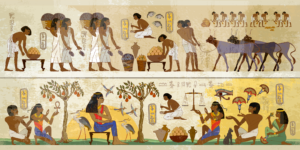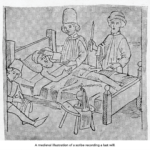
Amanda Farrell - 3 years ago

The origins of the modern notary professional are rooted in a deep history of professionals responsible for critical daily transactions and agreements. Thanks to notaries, many historians have the legal documents to piece together and preserve facts about the past.
One English historian, John Kenneth Hyde, praises notaries, saying, “The historian approaches Italian history in the thirteenth and fourteenth centuries almost exclusively through the writings of notaries.”
If you’ve ever wondered how the profession and the laws guiding it began, here is a condensed timeline!

Ancient Egypt was primarily a cashless society, relying on a complex bartering system to aid business transactions. The value of goods to be exchanged was measured against a third commodity to determine the conditions of the transaction. To finalize the agreement, a scribe (or sesh) marked down the weight of the commodity and certified the transaction.
These scribes are sometimes called kabbaneh or public weighers as well as notaries. The government employed them to act as impartial witnesses to commerce, setting up their scales in markets or other public places.
This tradition is traced back to 2750 B.C., and the custom of weighing goods and certifying the results for both parties to approve continues among the Baladi Egyptians.
These professionals had some of the cushier jobs in the royal court. They were exempt from manual labor, paying taxes, and joining the military. Much like the notarial ceremonies of today, these scribes performed oral ceremonies as part of their official service since most people were illiterate. The phrase, “May you be well when you hear this,” found at the end of ancient letters, indicates the scribes read aloud the documents.
A cartouche or shen (meaning to encircle) acted as an ancient seal. The item was also often worn as an amulet to protect from evil spirits, bring good luck, and signal the wearer’s status. More commonly, cartouches are found on the tombs of pharaohs.
Many scholars describe a man named Marcus Tullius Tiro as the first notary. Like in Ancient Egypt, literacy rates were low among the general population. Tiro is credited with developing a shorthand writing system called notae tironinae to record important speeches by the famed orator, Marcus Tuillius Cicero.
The shorthand system was adopted by those who recorded judicial proceedings. Eventually, these shorthand note-takers were given the title of Notarius, which serves as the root for notary.
Despite the similarity in titles, another group of public servants called tabularius provided services reminiscent of the modern notary in the United States. Like their Egyptian counterparts, the tabularius set up shop in the marketplace and assisted in recording either monetary transactions or other contracts.
Eventually, the professions developed to play a vital role in the formal recording of private law matters, like deeds, wills, and transfers of property.
Despite the eventual collapse of the Roman Empire, some of the customs and laws were retained. The role of the notary public was one such custom. At this time (around 800 A.D.), either the Emperor, Pope, or another official granted special privilege would publicly appoint notaries. The notary’s main function was to draw up internationally recognized instruments on behalf of all bishops, abbots, and counts. Although notaries served church officials, the duties were largely secular.
Like notaries today, these appointed officials were mainly concerned with authenticating and preserving records.
During the Middle Ages, the requirements and duties were codified based on Roman laws and spread to the northern regions of Europe. Some of those standard legal requirements now included:

The profession developed in England around the 13th or 14th century, mostly according to Norman feudal law, which was not influenced by Roman law. These two legal systems are often described as common law and civil law, respectively.
Much like in Italy, the early notaries of England were first appointed by and considered to be members of the clergy where they followed the customs of Roman civil law. Eventually, another class of secular or general notaries began to aid commercial matters and foreign trade based on common law.
However, the English notary never attained the same integral position within the common law system as the civil law notary. Under civil law, the notary is a branch of the legal profession drafting documents like wills, contracts, and deeds.
Much of the laws in the United States developed from English common law. With the exception of New Netherland (parts of modern-day New York, New Jersey, Connecticut, Pennsylvania, and Delaware), the American notary was an extension of the seventeenth-century English practice, which was mostly unregulated.
Meanwhile, the records from New Netherland shed light on the Dutch notarial practices of the same time, which was based on Roman laws.
As each colony became involved in trade, an appointed official with a high moral character was required to sign and seal documents to guarantee its authenticity.
Thomas Fugill was the first American colonist to bear the title of notary public in 1639. He and four other men were appointed by the General Court of the Province in New Haven Connecticut to “assist the magistrate in all courts called by him,” like the duties of notaries within the Roman and Ecclesiastical traditions.
Ironically, he was removed from his position and excommunicated by the Church after it was discovered that he granted more land to himself than he should have.
While Connecticut was the first colony to officially appoint a notary, the first general or common-law notary was appointed in Massachusetts in 1644.
Good record-keeping is the backbone of an economically stable society. Today, notaries in the United States are appointed by the governor of their state. Like ancient notaries, the modern notary is an essential part of commerce, assuring that the documents they notarize are authentic.
While the exact laws and methods guiding notaries may vary slightly from one state to another or from one country to the next, the underlying principle of preserving and authenticating recorded documents remains.
New methods like remote online notarization are becoming more popular, but the standard procedures of verifying signers’ identities, witnessing their signature, obtaining their verbal acknowledgment, and affixing a seal are unchanged.
This content is provided for informational purposes only. PropLogix, LLC (PLX) is not a law firm; this content is not intended as legal advice and may not be relied upon as such. PLX makes no representations as to the accuracy, reliability, or completeness of this content. PLX may reference or incorporate information from third-party sources, upon which a citation or a website URL shall be provided for such source. PLX does not endorse any third party or its products or services. Any comments referencing or responding to this content may be removed in the sole discretion of PLX.